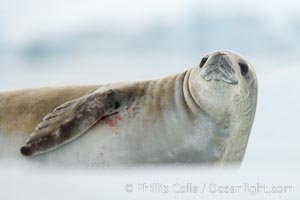
A crabeater seal, hauled out on pack ice to rest. Crabeater seals reach 2m and 200kg in size, with females being slightly larger than males. Crabeaters are the most abundant species of seal in the world, with as many as 75 million individuals. Despite its name, 80% the crabeater seal's diet consists of Antarctic krill. They have specially adapted teeth to strain the small krill from the water.
Species: Crabeater seal, Lobodon carcinophagus
Location: Neko Harbor, Antarctic Peninsula, Antarctica
Image ID: 25650
Species: Crabeater seal, Lobodon carcinophagus
Location: Neko Harbor, Antarctic Peninsula, Antarctica
Image ID: 25650
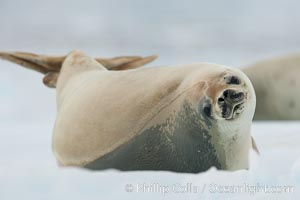
A crabeater seal, hauled out on pack ice to rest. Crabeater seals reach 2m and 200kg in size, with females being slightly larger than males. Crabeaters are the most abundant species of seal in the world, with as many as 75 million individuals. Despite its name, 80% the crabeater seal's diet consists of Antarctic krill. They have specially adapted teeth to strain the small krill from the water.
Species: Crabeater seal, Lobodon carcinophagus
Location: Neko Harbor, Antarctic Peninsula, Antarctica
Image ID: 25664
Species: Crabeater seal, Lobodon carcinophagus
Location: Neko Harbor, Antarctic Peninsula, Antarctica
Image ID: 25664
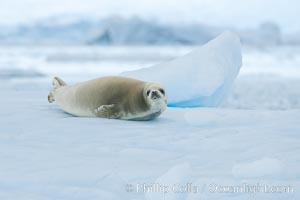
A crabeater seal, hauled out on pack ice to rest. Crabeater seals reach 2m and 200kg in size, with females being slightly larger than males. Crabeaters are the most abundant species of seal in the world, with as many as 75 million individuals. Despite its name, 80% the crabeater seal's diet consists of Antarctic krill. They have specially adapted teeth to strain the small krill from the water.
Species: Crabeater seal, Lobodon carcinophagus
Location: Neko Harbor, Antarctic Peninsula, Antarctica
Image ID: 25673
Species: Crabeater seal, Lobodon carcinophagus
Location: Neko Harbor, Antarctic Peninsula, Antarctica
Image ID: 25673
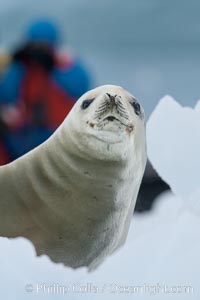
A crabeater seal, hauled out on pack ice to rest. Crabeater seals reach 2m and 200kg in size, with females being slightly larger than males. Crabeaters are the most abundant species of seal in the world, with as many as 75 million individuals. Despite its name, 80% the crabeater seal's diet consists of Antarctic krill. They have specially adapted teeth to strain the small krill from the water.
Species: Crabeater seal, Lobodon carcinophagus
Location: Neko Harbor, Antarctic Peninsula, Antarctica
Image ID: 25693
Species: Crabeater seal, Lobodon carcinophagus
Location: Neko Harbor, Antarctic Peninsula, Antarctica
Image ID: 25693
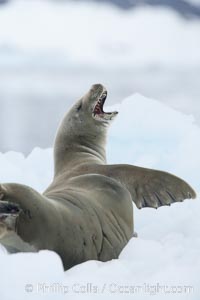
A crabeater seal, hauled out on pack ice to rest. Crabeater seals reach 2m and 200kg in size, with females being slightly larger than males. Crabeaters are the most abundant species of seal in the world, with as many as 75 million individuals. Despite its name, 80% the crabeater seal's diet consists of Antarctic krill. They have specially adapted teeth to strain the small krill from the water.
Species: Crabeater seal, Lobodon carcinophagus
Location: Neko Harbor, Antarctic Peninsula, Antarctica
Image ID: 25694
Species: Crabeater seal, Lobodon carcinophagus
Location: Neko Harbor, Antarctic Peninsula, Antarctica
Image ID: 25694
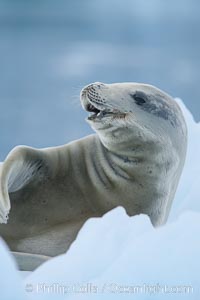
A crabeater seal, hauled out on pack ice to rest. Crabeater seals reach 2m and 200kg in size, with females being slightly larger than males. Crabeaters are the most abundant species of seal in the world, with as many as 75 million individuals. Despite its name, 80% the crabeater seal's diet consists of Antarctic krill. They have specially adapted teeth to strain the small krill from the water.
Species: Crabeater seal, Lobodon carcinophagus
Location: Neko Harbor, Antarctic Peninsula, Antarctica
Image ID: 25695
Species: Crabeater seal, Lobodon carcinophagus
Location: Neko Harbor, Antarctic Peninsula, Antarctica
Image ID: 25695
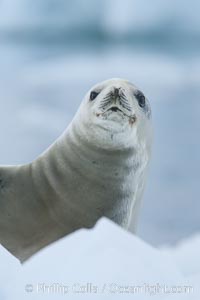
A crabeater seal, hauled out on pack ice to rest. Crabeater seals reach 2m and 200kg in size, with females being slightly larger than males. Crabeaters are the most abundant species of seal in the world, with as many as 75 million individuals. Despite its name, 80% the crabeater seal's diet consists of Antarctic krill. They have specially adapted teeth to strain the small krill from the water.
Species: Crabeater seal, Lobodon carcinophagus
Location: Neko Harbor, Antarctic Peninsula, Antarctica
Image ID: 25696
Species: Crabeater seal, Lobodon carcinophagus
Location: Neko Harbor, Antarctic Peninsula, Antarctica
Image ID: 25696
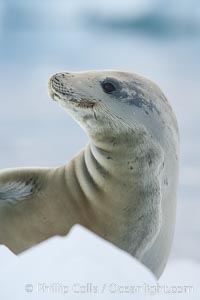
A crabeater seal, hauled out on pack ice to rest. Crabeater seals reach 2m and 200kg in size, with females being slightly larger than males. Crabeaters are the most abundant species of seal in the world, with as many as 75 million individuals. Despite its name, 80% the crabeater seal's diet consists of Antarctic krill. They have specially adapted teeth to strain the small krill from the water.
Species: Crabeater seal, Lobodon carcinophagus
Location: Neko Harbor, Antarctic Peninsula, Antarctica
Image ID: 25697
Species: Crabeater seal, Lobodon carcinophagus
Location: Neko Harbor, Antarctic Peninsula, Antarctica
Image ID: 25697
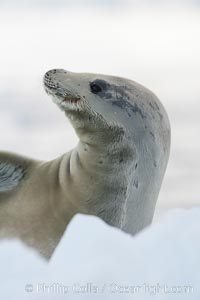
A crabeater seal, hauled out on pack ice to rest. Crabeater seals reach 2m and 200kg in size, with females being slightly larger than males. Crabeaters are the most abundant species of seal in the world, with as many as 75 million individuals. Despite its name, 80% the crabeater seal's diet consists of Antarctic krill. They have specially adapted teeth to strain the small krill from the water.
Species: Crabeater seal, Lobodon carcinophagus
Location: Neko Harbor, Antarctic Peninsula, Antarctica
Image ID: 25698
Species: Crabeater seal, Lobodon carcinophagus
Location: Neko Harbor, Antarctic Peninsula, Antarctica
Image ID: 25698
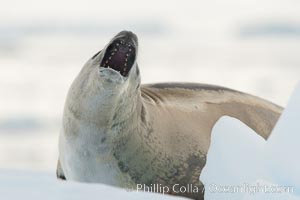
A crabeater seal, hauled out on pack ice to rest. Crabeater seals reach 2m and 200kg in size, with females being slightly larger than males. Crabeaters are the most abundant species of seal in the world, with as many as 75 million individuals. Despite its name, 80% the crabeater seal's diet consists of Antarctic krill. They have specially adapted teeth to strain the small krill from the water.
Species: Crabeater seal, Lobodon carcinophagus
Location: Neko Harbor, Antarctic Peninsula, Antarctica
Image ID: 25700
Species: Crabeater seal, Lobodon carcinophagus
Location: Neko Harbor, Antarctic Peninsula, Antarctica
Image ID: 25700
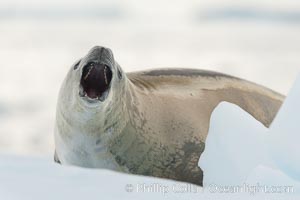
A crabeater seal, hauled out on pack ice to rest. Crabeater seals reach 2m and 200kg in size, with females being slightly larger than males. Crabeaters are the most abundant species of seal in the world, with as many as 75 million individuals. Despite its name, 80% the crabeater seal's diet consists of Antarctic krill. They have specially adapted teeth to strain the small krill from the water.
Species: Crabeater seal, Lobodon carcinophagus
Location: Neko Harbor, Antarctic Peninsula, Antarctica
Image ID: 25701
Species: Crabeater seal, Lobodon carcinophagus
Location: Neko Harbor, Antarctic Peninsula, Antarctica
Image ID: 25701
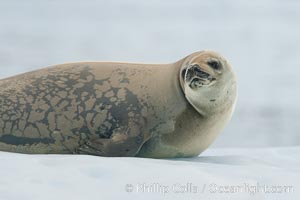
A crabeater seal, hauled out on pack ice to rest. Crabeater seals reach 2m and 200kg in size, with females being slightly larger than males. Crabeaters are the most abundant species of seal in the world, with as many as 75 million individuals. Despite its name, 80% the crabeater seal's diet consists of Antarctic krill. They have specially adapted teeth to strain the small krill from the water.
Species: Crabeater seal, Lobodon carcinophagus
Location: Neko Harbor, Antarctic Peninsula, Antarctica
Image ID: 25702
Species: Crabeater seal, Lobodon carcinophagus
Location: Neko Harbor, Antarctic Peninsula, Antarctica
Image ID: 25702
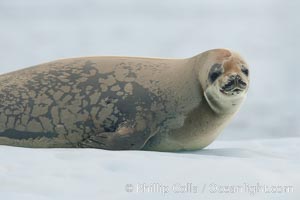
A crabeater seal, hauled out on pack ice to rest. Crabeater seals reach 2m and 200kg in size, with females being slightly larger than males. Crabeaters are the most abundant species of seal in the world, with as many as 75 million individuals. Despite its name, 80% the crabeater seal's diet consists of Antarctic krill. They have specially adapted teeth to strain the small krill from the water.
Species: Crabeater seal, Lobodon carcinophagus
Location: Neko Harbor, Antarctic Peninsula, Antarctica
Image ID: 25703
Species: Crabeater seal, Lobodon carcinophagus
Location: Neko Harbor, Antarctic Peninsula, Antarctica
Image ID: 25703
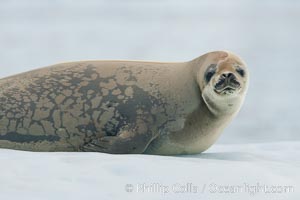
A crabeater seal, hauled out on pack ice to rest. Crabeater seals reach 2m and 200kg in size, with females being slightly larger than males. Crabeaters are the most abundant species of seal in the world, with as many as 75 million individuals. Despite its name, 80% the crabeater seal's diet consists of Antarctic krill. They have specially adapted teeth to strain the small krill from the water.
Species: Crabeater seal, Lobodon carcinophagus
Location: Neko Harbor, Antarctic Peninsula, Antarctica
Image ID: 25704
Species: Crabeater seal, Lobodon carcinophagus
Location: Neko Harbor, Antarctic Peninsula, Antarctica
Image ID: 25704
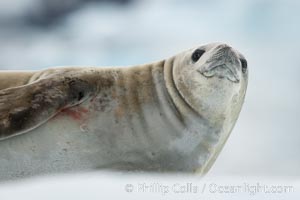
A crabeater seal, hauled out on pack ice to rest. Crabeater seals reach 2m and 200kg in size, with females being slightly larger than males. Crabeaters are the most abundant species of seal in the world, with as many as 75 million individuals. Despite its name, 80% the crabeater seal's diet consists of Antarctic krill. They have specially adapted teeth to strain the small krill from the water.
Species: Crabeater seal, Lobodon carcinophagus
Location: Neko Harbor, Antarctic Peninsula, Antarctica
Image ID: 25705
Species: Crabeater seal, Lobodon carcinophagus
Location: Neko Harbor, Antarctic Peninsula, Antarctica
Image ID: 25705
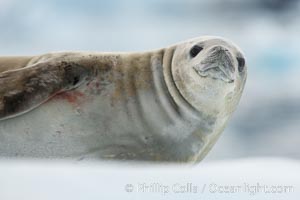
A crabeater seal, hauled out on pack ice to rest. Crabeater seals reach 2m and 200kg in size, with females being slightly larger than males. Crabeaters are the most abundant species of seal in the world, with as many as 75 million individuals. Despite its name, 80% the crabeater seal's diet consists of Antarctic krill. They have specially adapted teeth to strain the small krill from the water.
Species: Crabeater seal, Lobodon carcinophagus
Location: Neko Harbor, Antarctic Peninsula, Antarctica
Image ID: 25706
Species: Crabeater seal, Lobodon carcinophagus
Location: Neko Harbor, Antarctic Peninsula, Antarctica
Image ID: 25706
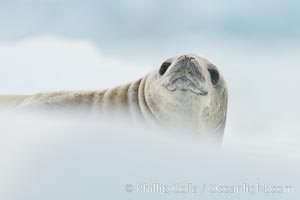
A crabeater seal, hauled out on pack ice to rest. Crabeater seals reach 2m and 200kg in size, with females being slightly larger than males. Crabeaters are the most abundant species of seal in the world, with as many as 75 million individuals. Despite its name, 80% the crabeater seal's diet consists of Antarctic krill. They have specially adapted teeth to strain the small krill from the water.
Species: Crabeater seal, Lobodon carcinophagus
Location: Neko Harbor, Antarctic Peninsula, Antarctica
Image ID: 25707
Species: Crabeater seal, Lobodon carcinophagus
Location: Neko Harbor, Antarctic Peninsula, Antarctica
Image ID: 25707
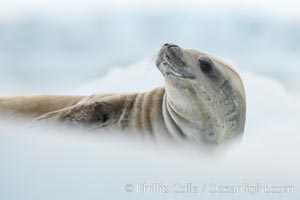
A crabeater seal, hauled out on pack ice to rest. Crabeater seals reach 2m and 200kg in size, with females being slightly larger than males. Crabeaters are the most abundant species of seal in the world, with as many as 75 million individuals. Despite its name, 80% the crabeater seal's diet consists of Antarctic krill. They have specially adapted teeth to strain the small krill from the water.
Species: Crabeater seal, Lobodon carcinophagus
Location: Neko Harbor, Antarctic Peninsula, Antarctica
Image ID: 25708
Species: Crabeater seal, Lobodon carcinophagus
Location: Neko Harbor, Antarctic Peninsula, Antarctica
Image ID: 25708
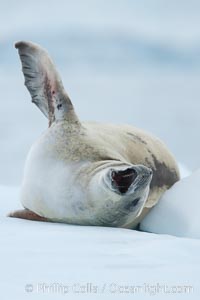
A crabeater seal, hauled out on pack ice to rest. Crabeater seals reach 2m and 200kg in size, with females being slightly larger than males. Crabeaters are the most abundant species of seal in the world, with as many as 75 million individuals. Despite its name, 80% the crabeater seal's diet consists of Antarctic krill. They have specially adapted teeth to strain the small krill from the water.
Species: Crabeater seal, Lobodon carcinophagus
Location: Neko Harbor, Antarctic Peninsula, Antarctica
Image ID: 25709
Species: Crabeater seal, Lobodon carcinophagus
Location: Neko Harbor, Antarctic Peninsula, Antarctica
Image ID: 25709
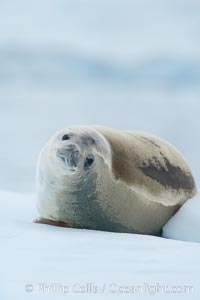
A crabeater seal, hauled out on pack ice to rest. Crabeater seals reach 2m and 200kg in size, with females being slightly larger than males. Crabeaters are the most abundant species of seal in the world, with as many as 75 million individuals. Despite its name, 80% the crabeater seal's diet consists of Antarctic krill. They have specially adapted teeth to strain the small krill from the water.
Species: Crabeater seal, Lobodon carcinophagus
Location: Neko Harbor, Antarctic Peninsula, Antarctica
Image ID: 25710
Species: Crabeater seal, Lobodon carcinophagus
Location: Neko Harbor, Antarctic Peninsula, Antarctica
Image ID: 25710
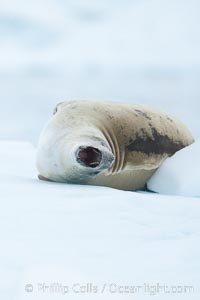
A crabeater seal, hauled out on pack ice to rest. Crabeater seals reach 2m and 200kg in size, with females being slightly larger than males. Crabeaters are the most abundant species of seal in the world, with as many as 75 million individuals. Despite its name, 80% the crabeater seal's diet consists of Antarctic krill. They have specially adapted teeth to strain the small krill from the water.
Species: Crabeater seal, Lobodon carcinophagus
Location: Neko Harbor, Antarctic Peninsula, Antarctica
Image ID: 25711
Species: Crabeater seal, Lobodon carcinophagus
Location: Neko Harbor, Antarctic Peninsula, Antarctica
Image ID: 25711
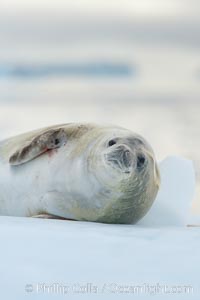
A crabeater seal, hauled out on pack ice to rest. Crabeater seals reach 2m and 200kg in size, with females being slightly larger than males. Crabeaters are the most abundant species of seal in the world, with as many as 75 million individuals. Despite its name, 80% the crabeater seal's diet consists of Antarctic krill. They have specially adapted teeth to strain the small krill from the water.
Species: Crabeater seal, Lobodon carcinophagus
Location: Neko Harbor, Antarctic Peninsula, Antarctica
Image ID: 25712
Species: Crabeater seal, Lobodon carcinophagus
Location: Neko Harbor, Antarctic Peninsula, Antarctica
Image ID: 25712
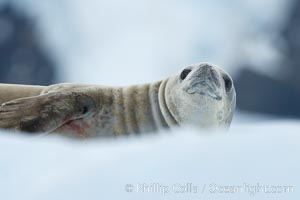
A crabeater seal, hauled out on pack ice to rest. Crabeater seals reach 2m and 200kg in size, with females being slightly larger than males. Crabeaters are the most abundant species of seal in the world, with as many as 75 million individuals. Despite its name, 80% the crabeater seal's diet consists of Antarctic krill. They have specially adapted teeth to strain the small krill from the water.
Species: Crabeater seal, Lobodon carcinophagus
Location: Neko Harbor, Antarctic Peninsula, Antarctica
Image ID: 25713
Species: Crabeater seal, Lobodon carcinophagus
Location: Neko Harbor, Antarctic Peninsula, Antarctica
Image ID: 25713
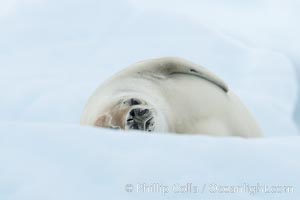
A crabeater seal, hauled out on pack ice to rest. Crabeater seals reach 2m and 200kg in size, with females being slightly larger than males. Crabeaters are the most abundant species of seal in the world, with as many as 75 million individuals. Despite its name, 80% the crabeater seal's diet consists of Antarctic krill. They have specially adapted teeth to strain the small krill from the water.
Species: Crabeater seal, Lobodon carcinophagus
Location: Neko Harbor, Antarctic Peninsula, Antarctica
Image ID: 25714
Species: Crabeater seal, Lobodon carcinophagus
Location: Neko Harbor, Antarctic Peninsula, Antarctica
Image ID: 25714
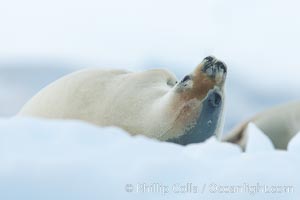
A crabeater seal, hauled out on pack ice to rest. Crabeater seals reach 2m and 200kg in size, with females being slightly larger than males. Crabeaters are the most abundant species of seal in the world, with as many as 75 million individuals. Despite its name, 80% the crabeater seal's diet consists of Antarctic krill. They have specially adapted teeth to strain the small krill from the water.
Species: Crabeater seal, Lobodon carcinophagus
Location: Neko Harbor, Antarctic Peninsula, Antarctica
Image ID: 25715
Species: Crabeater seal, Lobodon carcinophagus
Location: Neko Harbor, Antarctic Peninsula, Antarctica
Image ID: 25715
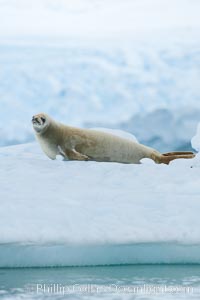
A crabeater seal, hauled out on pack ice to rest. Crabeater seals reach 2m and 200kg in size, with females being slightly larger than males. Crabeaters are the most abundant species of seal in the world, with as many as 75 million individuals. Despite its name, 80% the crabeater seal's diet consists of Antarctic krill. They have specially adapted teeth to strain the small krill from the water.
Species: Crabeater seal, Lobodon carcinophagus
Location: Neko Harbor, Antarctic Peninsula, Antarctica
Image ID: 25744
Species: Crabeater seal, Lobodon carcinophagus
Location: Neko Harbor, Antarctic Peninsula, Antarctica
Image ID: 25744
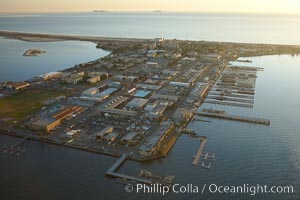
Naval Amphibious Base Coronado, situated on the Silver Strand between San Diego Bay and the Pacific Ocean, is the West Coast focal point for special and expeditionary warfare training and operations. The famous "swastika building" is seen on the southern (left) side of the base.
Location: San Diego, California
Image ID: 22298
Location: San Diego, California
Image ID: 22298
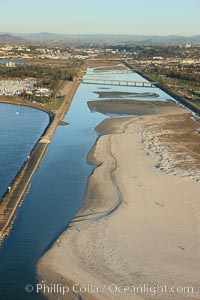
San Diego River, constrained by levees and jetties on both its north and south sides, just before it empties into the Pacific Ocean south of Mission Beach.
Location: San Diego, California
Image ID: 22303
Location: San Diego, California
Image ID: 22303
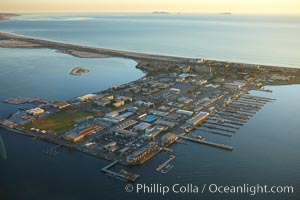
Naval Amphibious Base Coronado, situated on the Silver Strand between San Diego Bay and the Pacific Ocean, is the West Coast focal point for special and expeditionary warfare training and operations. The famous "swastika building" is seen on the southern (left) side of the base.
Location: San Diego, California
Image ID: 22329
Location: San Diego, California
Image ID: 22329

A photographer trains his camera on a bright orange bloom of California poppies.
Species: California poppy, Eschscholtzia californica, Eschscholzia californica
Location: Elsinore, California
Image ID: 20503
Species: California poppy, Eschscholtzia californica, Eschscholzia californica
Location: Elsinore, California
Image ID: 20503